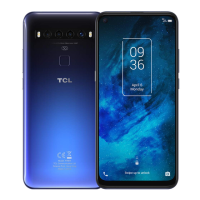
Do you have a question about the TCL 10 5G and is the answer not in the manual?
| Panel type | LCD |
|---|---|
| Screen shape | Flat |
| Pixel density | 395 ppi |
| Display diagonal | 6.53 \ |
| Display brightness | 450 cd/m² |
| Display resolution | 1080 x 2340 pixels |
| Native aspect ratio | 19.5:9 |
| Processor cores | 4 |
| Processor model | 765G |
| Processor family | Qualcomm Snapdragon |
| Processor frequency | 2.4 GHz |
| User memory | 103 GB |
| RAM capacity | 6 GB |
| Compatible memory cards | SDXC |
| Maximum memory card size | 1000 GB |
| Internal storage capacity | 128 GB |
| Flash type | LED |
| Digital zoom | 10 x |
| Rear camera type | Quad camera |
| Front camera type | Single camera |
| Maximum frame rate | 60 fps |
| Rear camera pixel size | 0.8 µm |
| Front camera pixel size | 1 µm |
| Front camera aperture number | 2.2 |
| Second rear camera pixel size | 1.12 µm |
| Video capture resolution (max) | 1080 x 1920 pixels |
| Rear camera resolution (numeric) | 64 MP |
| Front camera resolution (numeric) | 16 MP |
| Rear camera field of view (FOV) angle | 79.8 ° |
| Front camera field of view (FOV) angle | 79.1 ° |
| Third rear camera resolution (numeric) | 5 MP |
| Fourth rear camera resolution (numeric) | 2 MP |
| Second rear camera resolution (numeric) | 8 MP |
| Third rear camera field of view (FOV) angle | 83.2 ° |
| Second rear camera field of view (FOV) angle | 118 ° |
| 4G standard | LTE |
| 3G standards | HSPA |
| SIM card type | NanoSIM |
| Wi-Fi standards | 802.11a, 802.11b, 802.11g, Wi-Fi 4 (802.11n), Wi-Fi 5 (802.11ac) |
| Bluetooth version | 5.0 |
| SIM card capability | Single SIM |
| Mobile network generation | 5G |
| USB version | 2.0 |
| USB connector type | USB Type-C |
| Headphone connectivity | 3.5 mm |
| Multimedia Messaging Service (MMS) | Multimedia Messaging Service (MMS) is a standard way to send messages that include multimedia content to and from a mobile phone over a cellular network |
| Color name | Chrome Blue |
| Form factor | Bar |
| Product color | Blue |
| Refurbished | No |
| Graphics card | Adreno 620 |
| Speakers | Mono |
| Platform | Android |
| Operating system installed | Android 10.0 |
| Talk time (3G) | 26 h |
| Battery capacity | 4500 mAh |
| Standby time (3G) | 580 h |
| Standby time (4G) | 529 h |
| Battery technology | - |
| Depth | 9.05 mm |
|---|---|
| Width | 76.56 mm |
| Height | 163.65 mm |
| Weight | 210 g |
Overview of physical buttons, ports, and their functions.
Instructions for initial phone setup and configuration.
Explanation of the main user interface and its elements.
Guide to typing, symbols, and keyboard settings.
Methods for cutting, copying, pasting, and modifying text.
Making, receiving, and managing phone calls.
Accessing and managing the call history log.
Adding, editing, and managing contact information.
Creating and sending SMS and MMS messages.
Creating, editing, and managing calendar events.
Using alarms, timers, and the stopwatch function.
Basic and advanced calculator functionalities.
Setting up mobile data, Wi-Fi, and APNs.
Pairing and managing Bluetooth connections.
Transferring files using a USB cable.
Using the phone as a Wi-Fi hotspot or USB tethering.
Setting up and managing VPN connections.
Using the camera for photos and videos, modes, and settings.
Viewing, editing, and sharing photos and videos.
Accessing FAQs, contact information, and feedback options.
Information about pre-installed third-party applications.
Web browsing with Google Chrome.
Using the Gmail email service.
Navigation and location services with Google Maps.
Watching and sharing videos on YouTube.
Cloud storage and file synchronization with Google Drive.
Downloading and managing apps from Google Play Store.
Video chat functionality with Google Duo.
Storing, organizing, and backing up photos with Google Photos.
Creating and managing notes with Google Keep.
Using the voice-activated Google Assistant.
Managing files stored on the device and SD card.
Configuring network connections, data usage, and Wi-Fi.
Managing Bluetooth, NFC, and other device connections.
Adjusting screen settings like brightness, font, and dark mode.
Enhancing visual quality with specific display modes.
Customizing the home screen, icons, and wallpapers.
Setting ringtones, notification sounds, and volume.
Configuring special functions like gestures, one-handed mode.
Optimizing performance, battery, and storage.
Setting up screen lock, fingerprint, and app protection.
Managing location services and app permissions.
Controlling app access to personal data and settings.
Viewing app details, managing usage, and permissions.
Monitoring and managing device storage space.
Adding, removing, and managing user accounts.
Monitoring phone usage and setting limits for children.
Configuring Google account and services.
Customizing settings for users with disabilities.
Viewing device information, status, and legal notices.
Opting into programs to improve user experience.
Checking for and installing software updates.
Setting language, keyboard, and input methods.
Configuring the device's date and time settings.
Backing up device settings and data to Google servers.
Performing network, app, or factory data resets.
Viewing product compliance and safety information.
Updating phone software via Firmware Over The Air.
Precautions for using the phone while driving.
Guidelines for optimal phone performance and safety in various environments.